Reuben Casserole
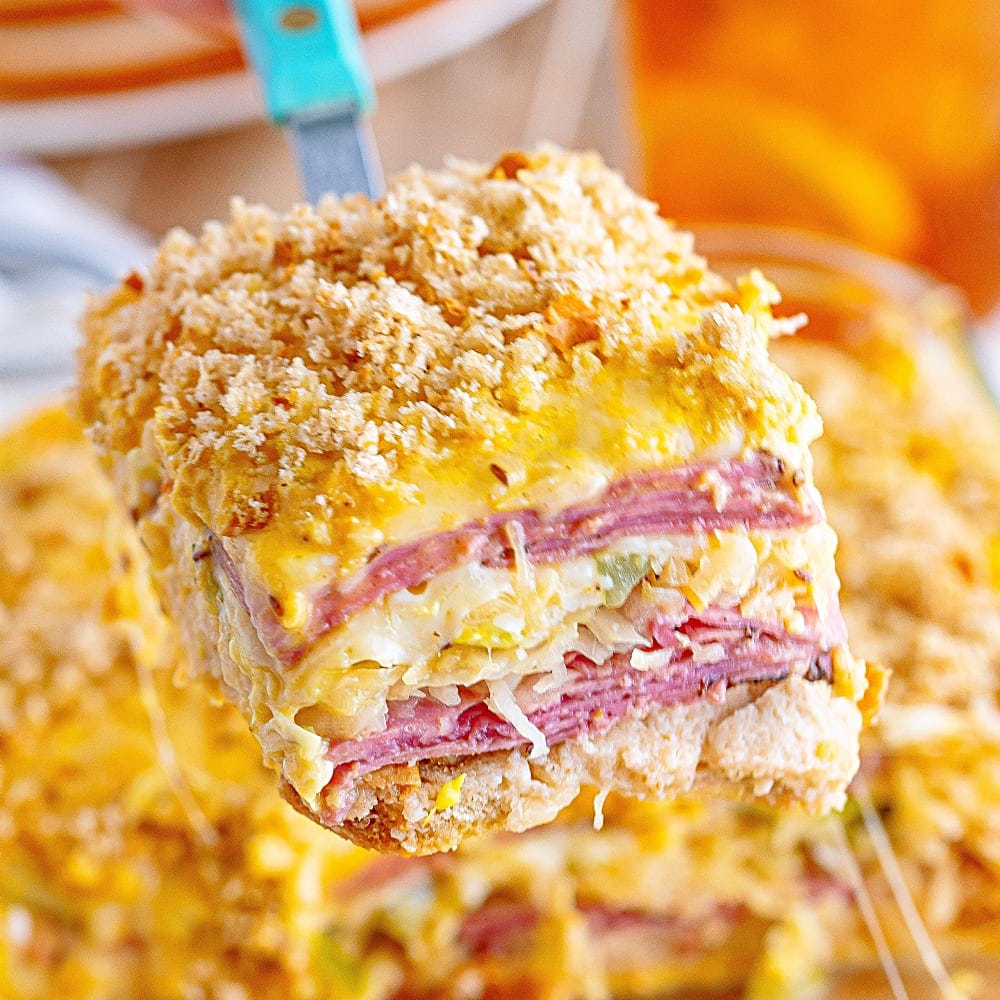
Get ready to fall head over heels for the ultimate comfort food mashup!
This Reuben Casserole takes everything you absolutely love about that iconic deli sandwich and transforms it into a bubbling, golden casserole that’ll have your entire family fighting over seconds.
We’re talking layers of tender rye bread, savory pastrami, tangy sauerkraut, and melted Swiss cheese all bound together with a creamy custard base that’s pure magic.
The aroma alone will have neighbors knocking on your door, and the taste?
Let’s just say it’s about to become your new go-to recipe for potlucks, family dinners, and any time you want to feel like a culinary genius.
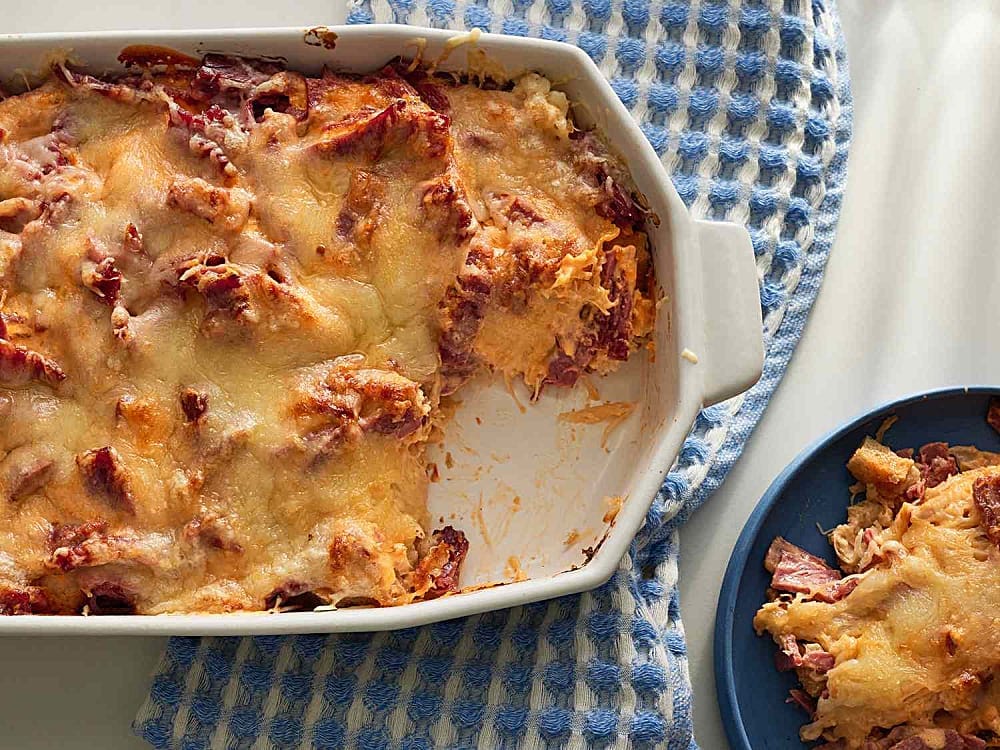
What makes this casserole absolutely irresistible is how it captures every single flavor from a classic Reuben sandwich but makes it infinitely more shareable and satisfying.
The rye bread creates the perfect foundation, soaking up all those incredible flavors while maintaining just enough texture to keep things interesting.
Those caraway seeds scattered throughout add little bursts of that distinctive rye flavor, while the dill pickles bring a delightful crunch and tang that cuts through the richness beautifully.
And that custard base made with thousand island dressing and mustard?
It’s like having the perfect Reuben sauce distributed throughout every single bite.
Trust me, once you make this, regular sandwiches just won’t cut it anymore.
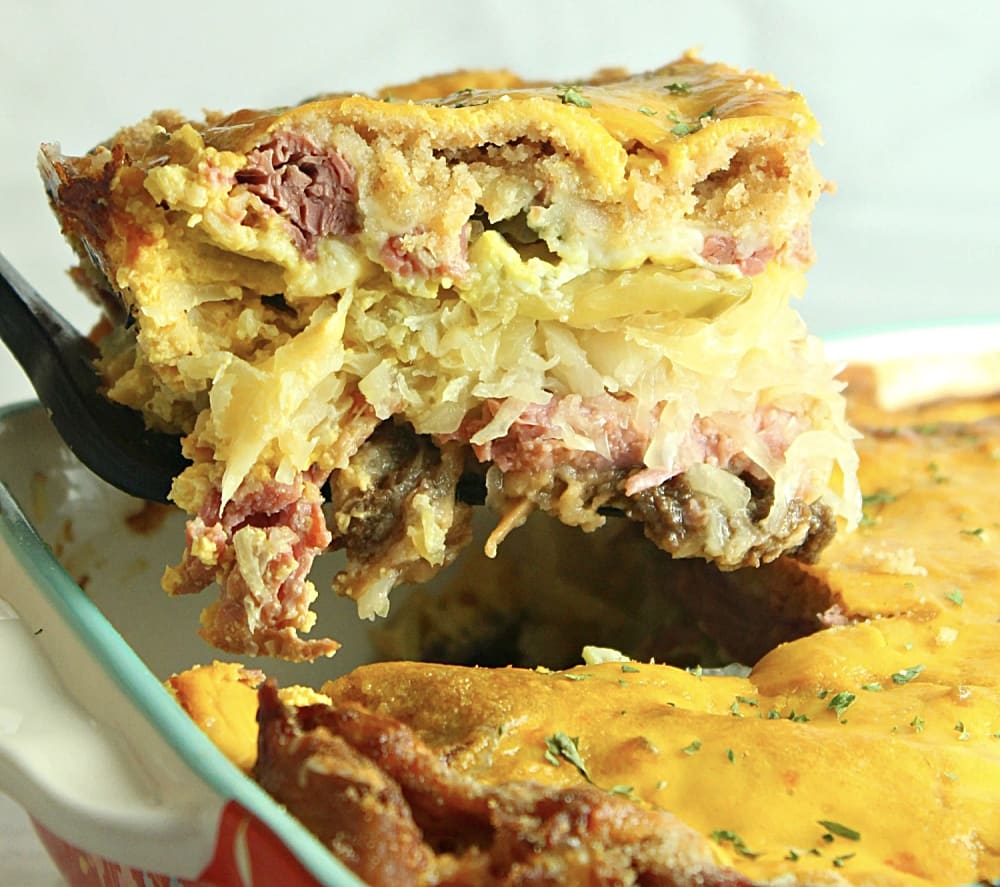
Ingredients
For the bread base
- 6 slices rye bread (dark or light, divided use)
- 2 teaspoons caraway seeds (divided use)
For the protein and vegetables
- 1 pound thinly sliced pastrami or corned beef (divided use)
- 14 .5 ounce can or jar sauerkraut, drained very well
- 1 cup chopped dill pickles
For the cheese layer
- 4 cups shredded Swiss cheese (divided use)
For the custard base
- 1 cup milk
- 3 large eggs, beaten
- ⅓ cup thousand island dressing
- ¼ cup yellow mustard
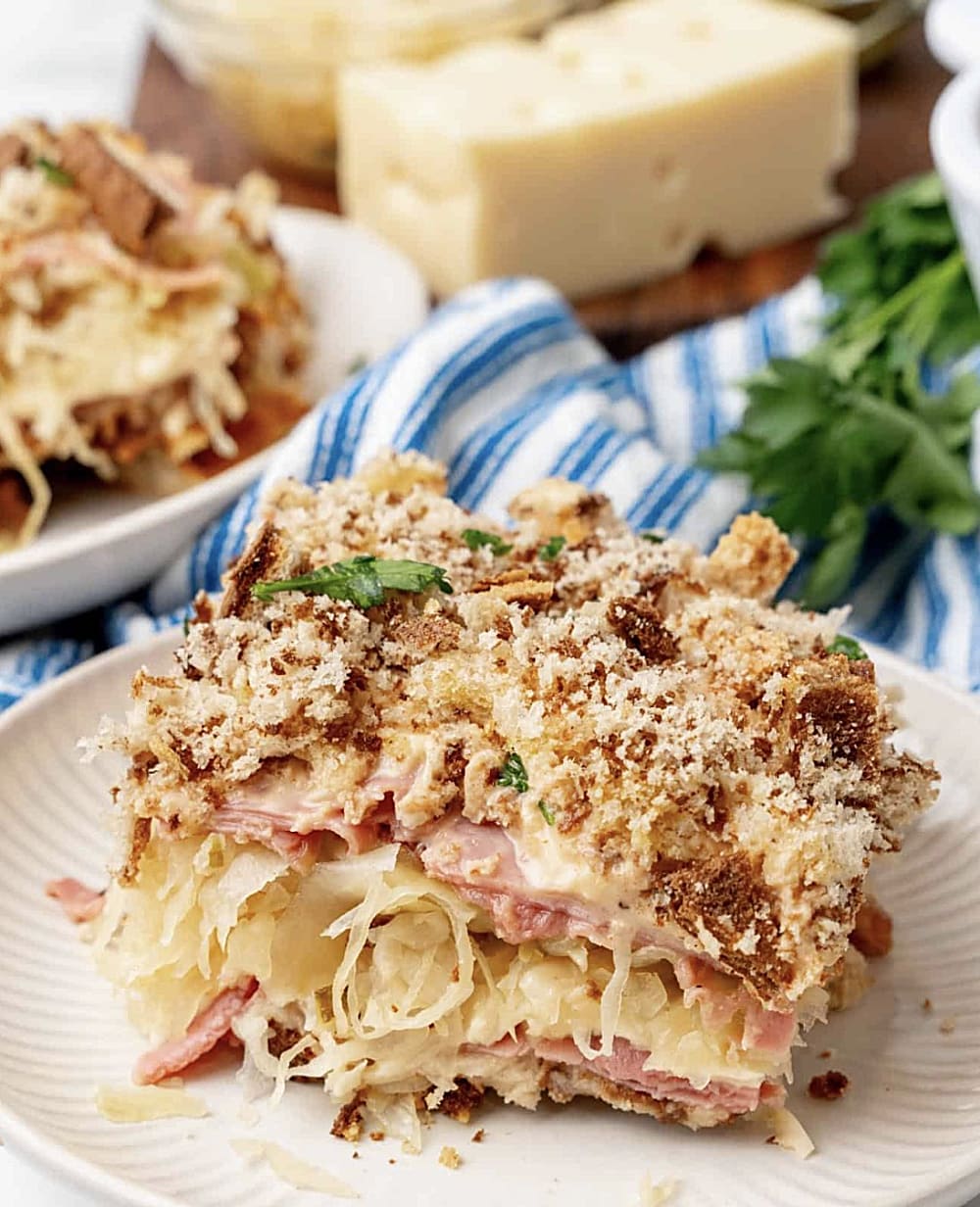
Instructions
Preparation
- 1 Preheat oven to 350°F (175°C) and spray an 11×7-inch or 9×13-inch baking dish with nonstick cooking spray. The larger dish will create a thinner casserole that bakes more evenly, while the smaller dish gives you deeper, more substantial layers.
- 2 Take 4 slices of rye bread and cut them into 2-inch cubes. This size ensures the bread pieces hold their shape while still absorbing the custard mixture perfectly. Spread the cubed rye bread evenly into the bottom of your prepared baking dish, creating a sturdy foundation layer.
- 3 Place the remaining 2 slices of rye bread into a food processor and pulse until you achieve fine breadcrumbs. These will create a beautiful golden topping that adds textural contrast. Set these breadcrumbs aside for later use.
Building the layers
- 4 Cover the cubed rye bread evenly with half of the pastrami. Don’t worry about perfect placement – rustic layering actually helps the flavors meld better during baking.
- 5 Evenly distribute the well-drained sauerkraut, 1 cup chopped dill pickles, and 1 teaspoon caraway seeds over the pastrami layer. Make sure to drain that sauerkraut thoroughly – excess moisture can make your casserole soggy instead of perfectly set.
- 6 Sprinkle 2 cups of the shredded Swiss cheese evenly over the sauerkraut layer. This middle cheese layer helps bind all the flavors together while creating those irresistible cheese pulls when serving.
- 7 Top with the remaining pastrami, then gently push down on all the layers to help compact them slightly. This compression helps the custard penetrate all the layers more effectively.
- 8 Sprinkle the remaining 2 cups Swiss cheese and remaining 1 teaspoon caraway seeds on top of the final pastrami layer.
Creating the custard and finishing
- 9 In a medium bowl, whisk together 1 cup milk, 3 beaten eggs, ⅓ cup thousand island dressing, and ¼ cup yellow mustard until completely smooth. This custard base is what transforms separate ingredients into a cohesive, sliceable casserole.
- 10 Pour the custard mixture evenly over the entire casserole, making sure it reaches all corners. The liquid should settle down through the layers – this is exactly what you want.
- 11 Top with the reserved rye breadcrumbs for that perfect golden, crunchy finish that mimics toasted sandwich bread.
- 12 Cover tightly with aluminum foil and bake for 45 minutes. The foil prevents the top from browning too quickly while ensuring the interior cooks through completely.
- 13 Remove from oven and let rest for 5 minutes before slicing and serving. This resting time allows the custard to set properly, making clean slices possible.
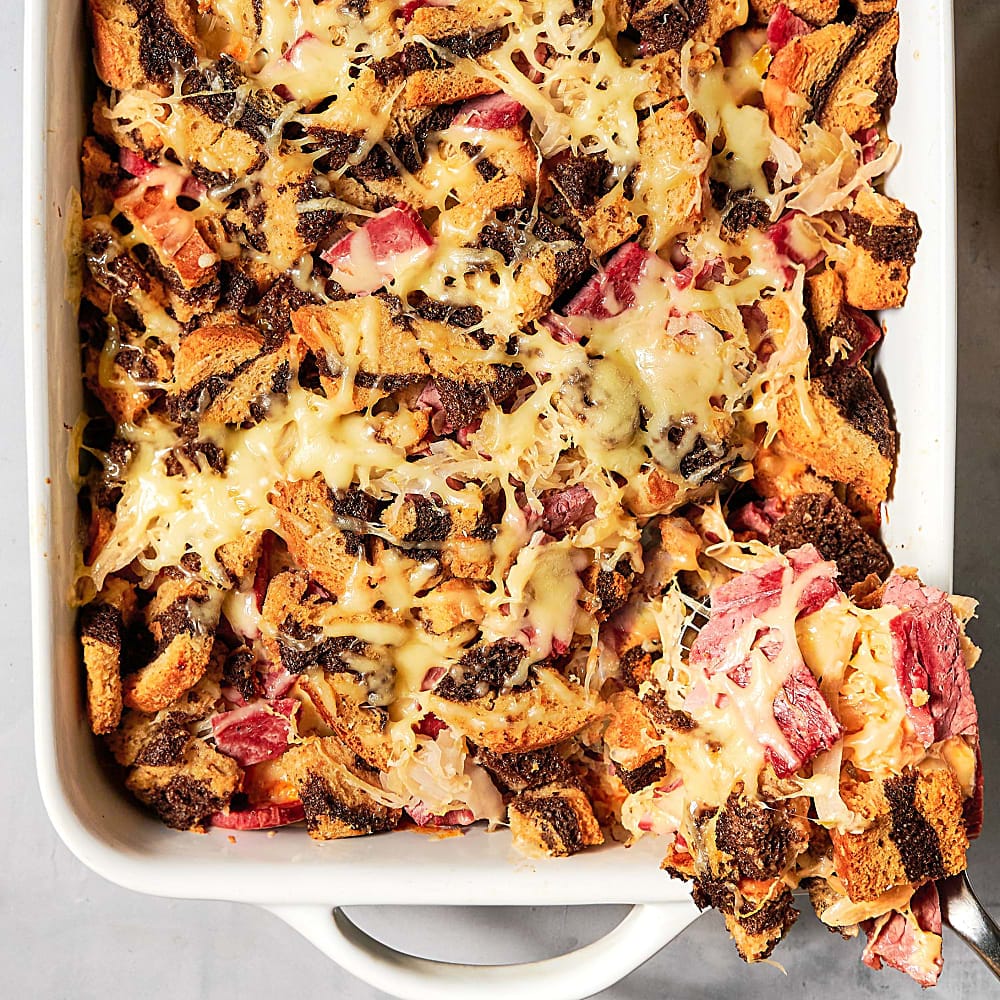
Recommended Equipment and Kitchen Tools
Recommended Tools (for best results):
- Food processor – Essential for creating uniform breadcrumbs that toast evenly and provide the perfect textural contrast to the creamy interior
- Large mixing bowls – You’ll need space to whisk the custard mixture thoroughly without splashing
- Sharp chef’s knife – Makes quick work of cubing bread and chopping pickles to consistent sizes
- Quality baking dish – A heavy-duty glass or ceramic dish distributes heat evenly for consistent cooking
Helpful Upgrades:
- Kitchen scale – For precise measurements, especially when dividing ingredients like cheese and pastrami between layers
- Silicone spatula – Perfect for scraping every bit of that precious custard mixture from the bowl
- Instant-read thermometer – Ensures your casserole reaches the safe internal temperature of 165°F (74°C)
Nice-to-Have Options:
- Bench scraper – Makes transferring chopped ingredients and breadcrumbs much easier
- Aluminum foil – Heavy-duty foil prevents tearing and provides better heat distribution during covered baking
- Storage containers – Glass containers with tight-fitting lids keep leftovers fresh and make reheating simple
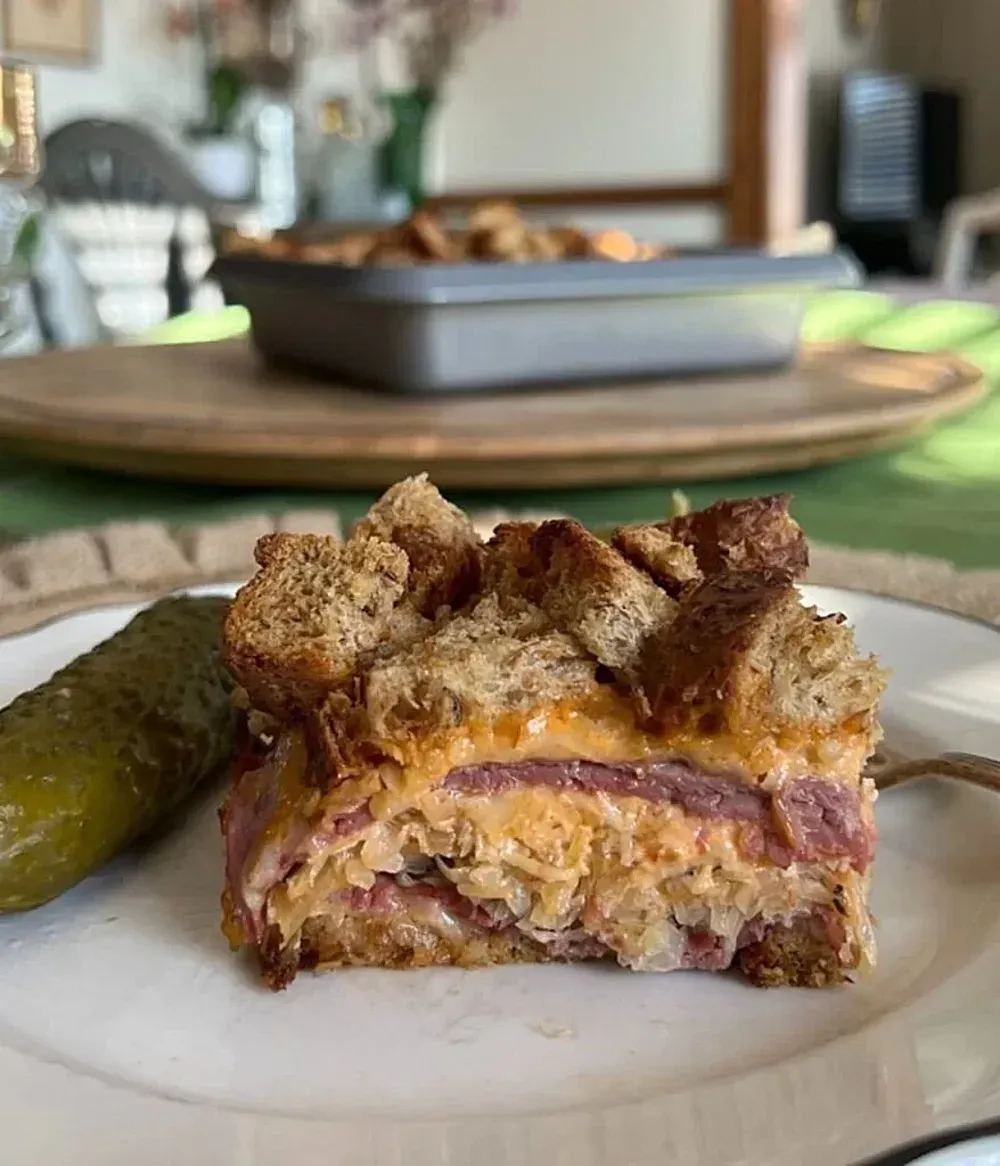
Recipe Variations and Dietary Modifications
Gluten-Free Adaptation:
- Replace rye bread with gluten-free bread (use sturdy varieties like sourdough-style)
- Ensure your thousand island dressing and mustard are certified gluten-free
- Consider adding 1 tablespoon cornstarch to the custard for extra binding power
- Baking time may increase by 5-10 minutes due to different bread density
Dairy-Free Modifications:
- Substitute Swiss cheese with dairy-free Swiss-style cheese (use same amount)
- Replace milk with unsweetened oat milk or cashew milk for richness
- Check that your thousand island dressing is dairy-free or make your own
- The texture will be slightly less creamy but still delicious
Lower-Sodium Version:
- Use low-sodium pastrami or turkey pastrami as alternatives
- Rinse sauerkraut thoroughly and choose low-sodium varieties
- Make homemade thousand island with Greek yogurt and reduced-sodium ingredients
- Add extra caraway seeds and black pepper to boost flavor without salt
Flavor Variations:
- Rachel Casserole: Replace sauerkraut with coleslaw mix and pastrami with turkey
- Spicy Version: Add 2 tablespoons horseradish to the custard mixture
- Smoky Twist: Use smoked Swiss cheese and add 1 teaspoon smoked paprika
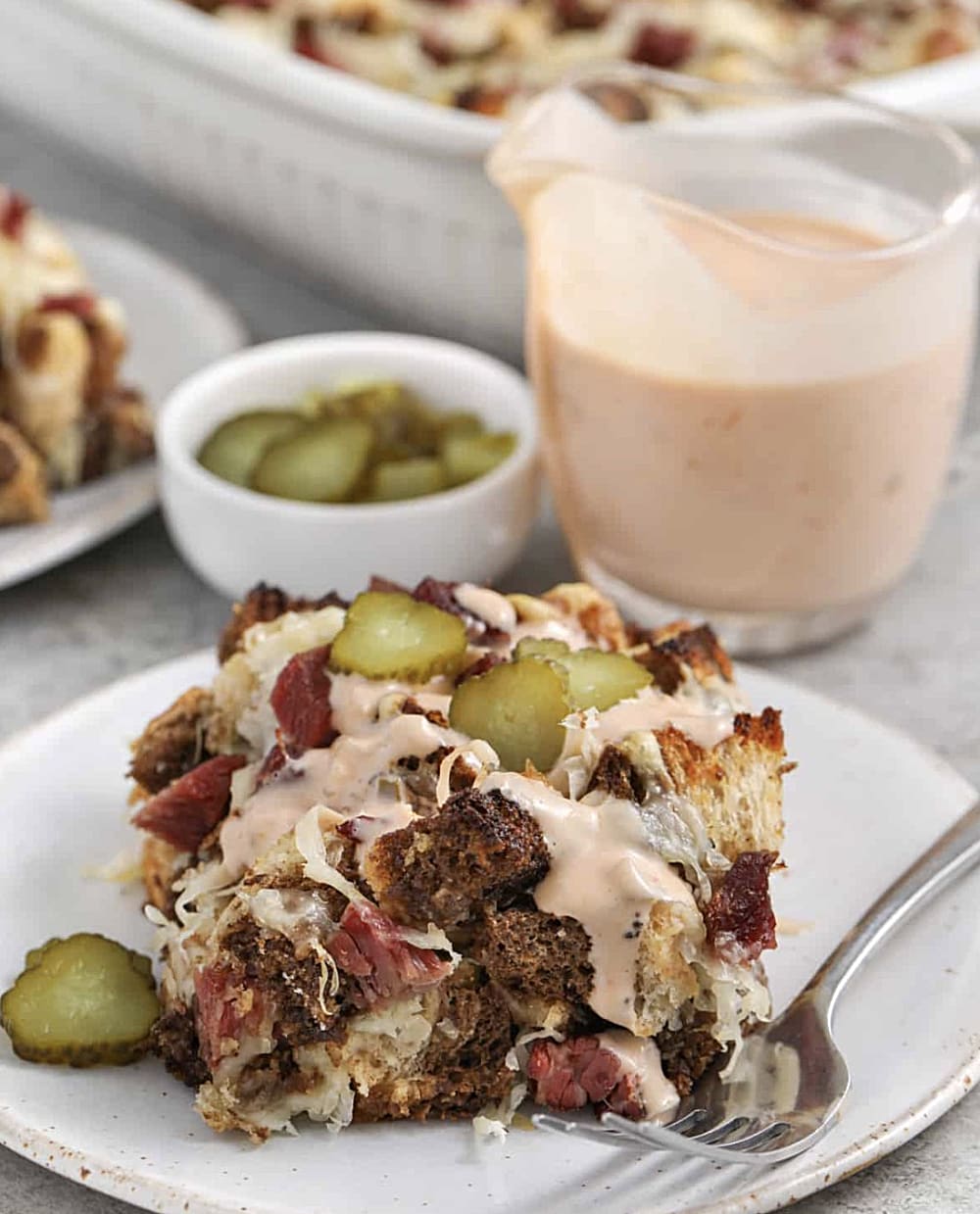
Nutritional Information and Health Benefits
Key Nutritional Highlights:
This hearty casserole provides approximately 385 calories per serving with a substantial 28 grams of protein from the pastrami and Swiss cheese combination. The high protein content makes this an excellent choice for maintaining satiety and supporting muscle health. Each serving delivers about 18 grams of fat, primarily from the cheese and eggs, along with 22 grams of carbohydrates from the rye bread base.
Health Benefits of Main Ingredients:
The sauerkraut in this recipe is a nutritional powerhouse, providing beneficial probiotics that support digestive health and immune function. These fermented vegetables also contain vitamin C and vitamin K, essential for immune support and bone health. Swiss cheese contributes significant amounts of calcium and phosphorus for strong bones and teeth, while the eggs provide complete protein and choline for brain health. Rye bread offers more fiber and B-vitamins compared to white bread, supporting digestive health and energy metabolism.
Dietary Considerations:
This recipe contains gluten (from rye bread), dairy (cheese and milk), and eggs, making it unsuitable for those with these specific allergies. However, it’s naturally nut-free and provides a good balance of macronutrients. The caraway seeds add antioxidants and may help with digestion, while the pickles contribute minimal calories but significant flavor and some beneficial probiotics if naturally fermented.
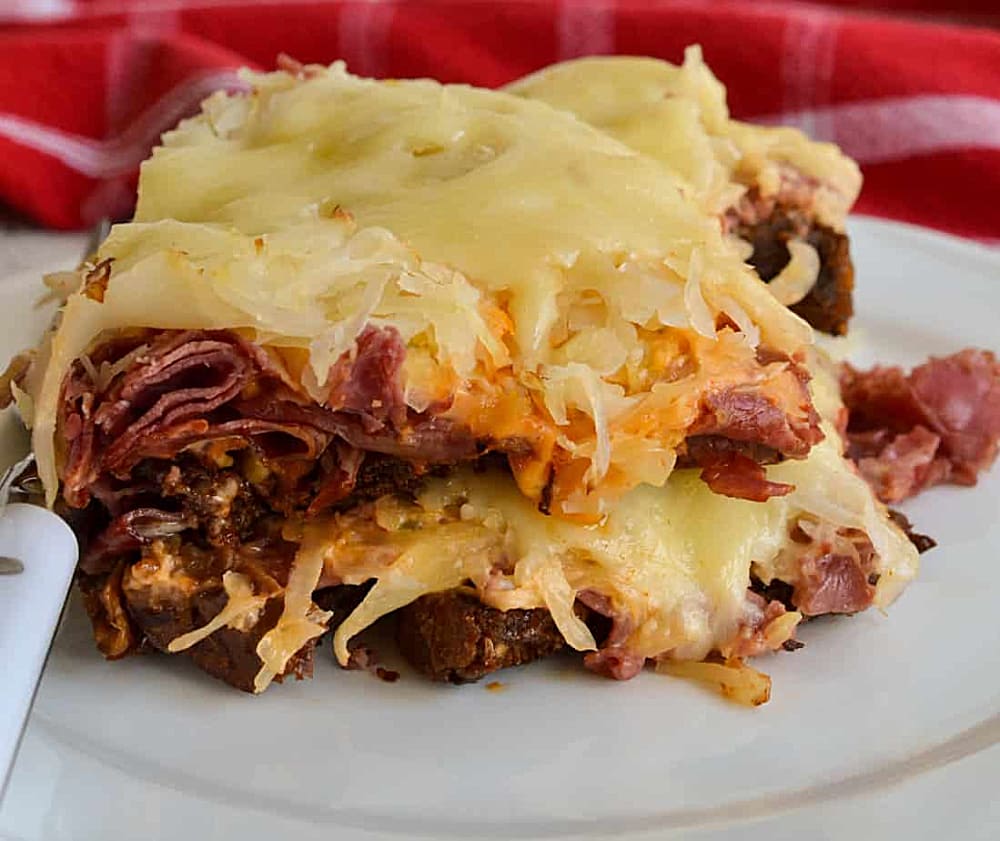
Smart Swaps and Ingredient Substitutions
Common Substitutions:
- Pastrami → Corned beef, turkey pastrami, or ham (use same amount)
- Swiss cheese → Gruyere, provolone, or white cheddar for different flavor profiles
- Thousand island dressing → Russian dressing or homemade mayo-ketchup blend
- Yellow mustard → Dijon mustard or whole grain mustard for more complex flavor
Budget-Friendly Swaps:
- Deli pastrami → Sliced pastrami from the packaged meat section (often half the price)
- Fresh rye bread → Day-old rye bread from bakery discount section (actually works better for cubing)
- Block Swiss cheese → Pre-shredded Swiss when on sale (though block cheese melts better)
Pantry Emergency Substitutions:
- Sauerkraut → Coleslaw mix dressed with vinegar and salt (let sit 30 minutes)
- Dill pickles → Sweet pickles chopped fine, or pickle relish drained
- Caraway seeds → Fennel seeds or dill seeds for similar aromatic qualities
Pro Tips for Substitutions:
- When using different meats, maintain the 1-pound total weight for proper custard-to-filling ratio
- Store opened sauerkraut in refrigerator for up to 2 weeks in original liquid
- Freeze extra rye bread specifically for this recipe – it cubes better when slightly stale
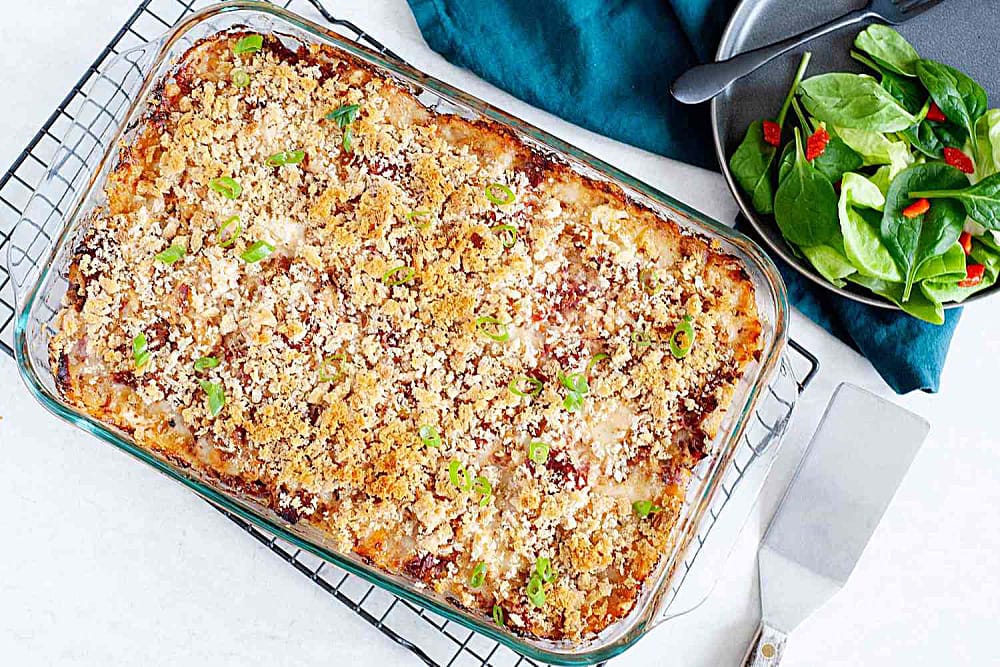
Make It Diabetes-Friendly
Carb Reduction Strategies:
- Replace 2 slices of the rye bread with cauliflower florets (blanched and drained) to reduce carbs by approximately 15 grams
- Use sugar-free thousand island dressing to eliminate hidden sugars
- Choose low-carb rye bread alternatives that contain 3-5 grams net carbs per slice instead of regular rye’s 12 grams
Portion & Blood Sugar Management:
- Serve smaller portions (⅛ of the casserole instead of 1/12) paired with a large green salad
- The high protein content (28g per serving) helps slow carbohydrate absorption
- Total carbohydrates per standard serving: approximately 22 grams; modified version: 12 grams
Smart Pairing Tips:
- Start meals with 2 cups of leafy greens dressed with olive oil and vinegar
- Add roasted broccoli or green beans as sides to increase fiber
- The fat and protein content naturally helps moderate blood sugar spikes
Timing Recommendations:
- Best served as a lunch option when you can be more active afterward
- Consider having half portions with extra vegetables to maintain satisfaction while managing carbs
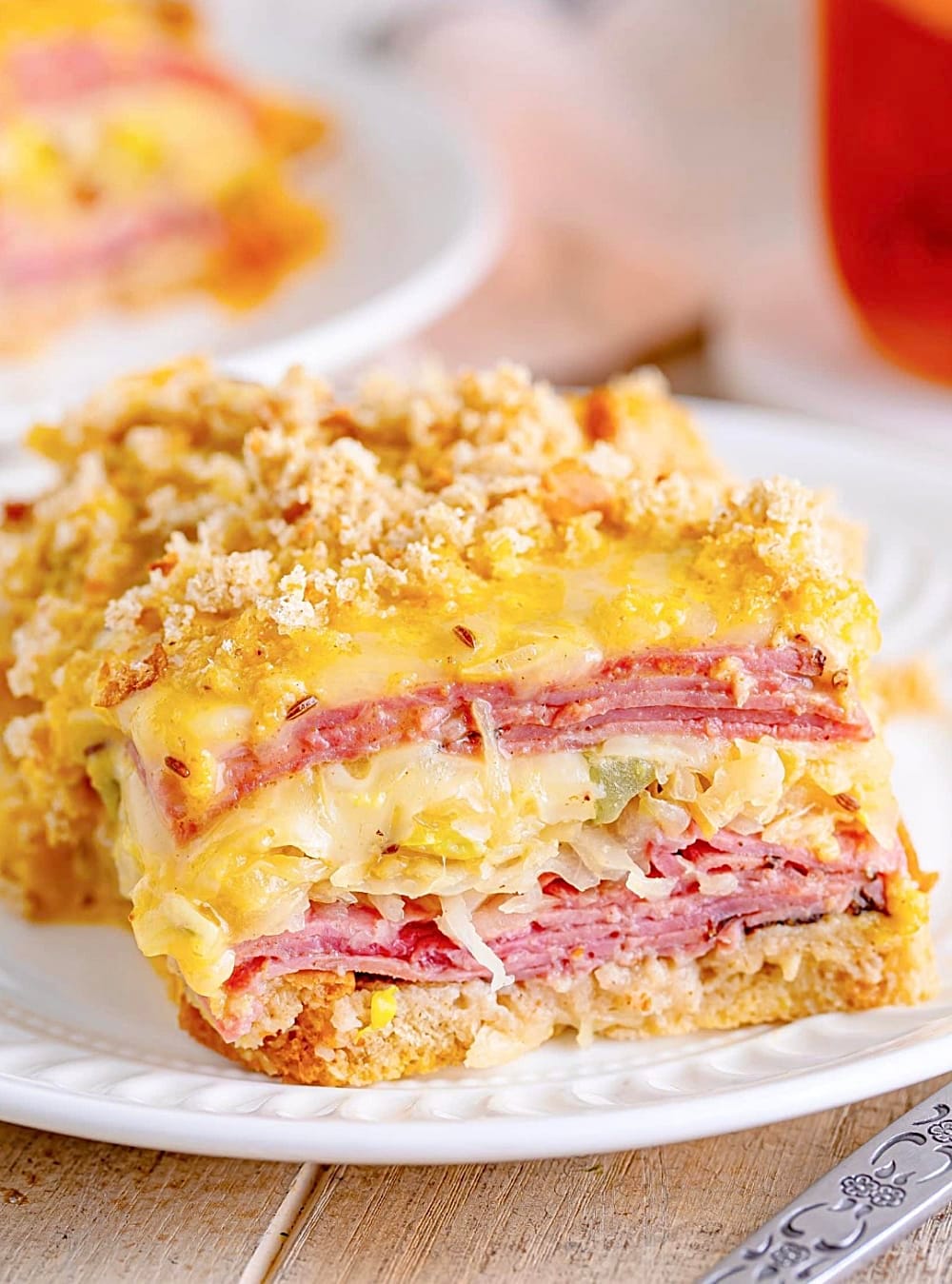
Perfect Pairing Suggestions
Beverage Pairings:
A crisp German Riesling or Gewürztraminer beautifully complements the tangy sauerkraut and rich cheese flavors, while their slight sweetness balances the saltiness perfectly. For beer lovers, a Czech pilsner or German lager echoes the traditional flavors of a classic Reuben. Non-alcoholic options include sparkling apple cider with a splash of cranberry juice, or iced tea with lemon to cut through the richness.
Side Dish Recommendations:
Crisp coleslaw with a vinegar-based dressing provides refreshing contrast to the warm, rich casserole. Roasted Brussels sprouts with bacon bits echo the Germanic flavors while adding healthy vegetables. German potato salad served warm makes this a complete comfort food feast, while pickled beets add color and tangy contrast. For lighter options, try cucumber salad with dill or mixed greens with apple slices and walnuts.
Complete Meal Ideas:
Start with pretzel rolls and beer cheese dip for appetizers that complement the German-inspired theme. Follow the casserole with apple strudel or black forest cake for an authentic German meal experience. For casual entertaining, serve alongside bratwurst, sauerkraut balls, and German mustard for a complete Oktoberfest-style spread.
Occasion Suggestions:
Perfect for Sunday family dinners, potluck gatherings, and cold weather entertaining. This casserole shines at game day parties, casual dinner parties, and holiday brunches where you want something hearty and crowd-pleasing.
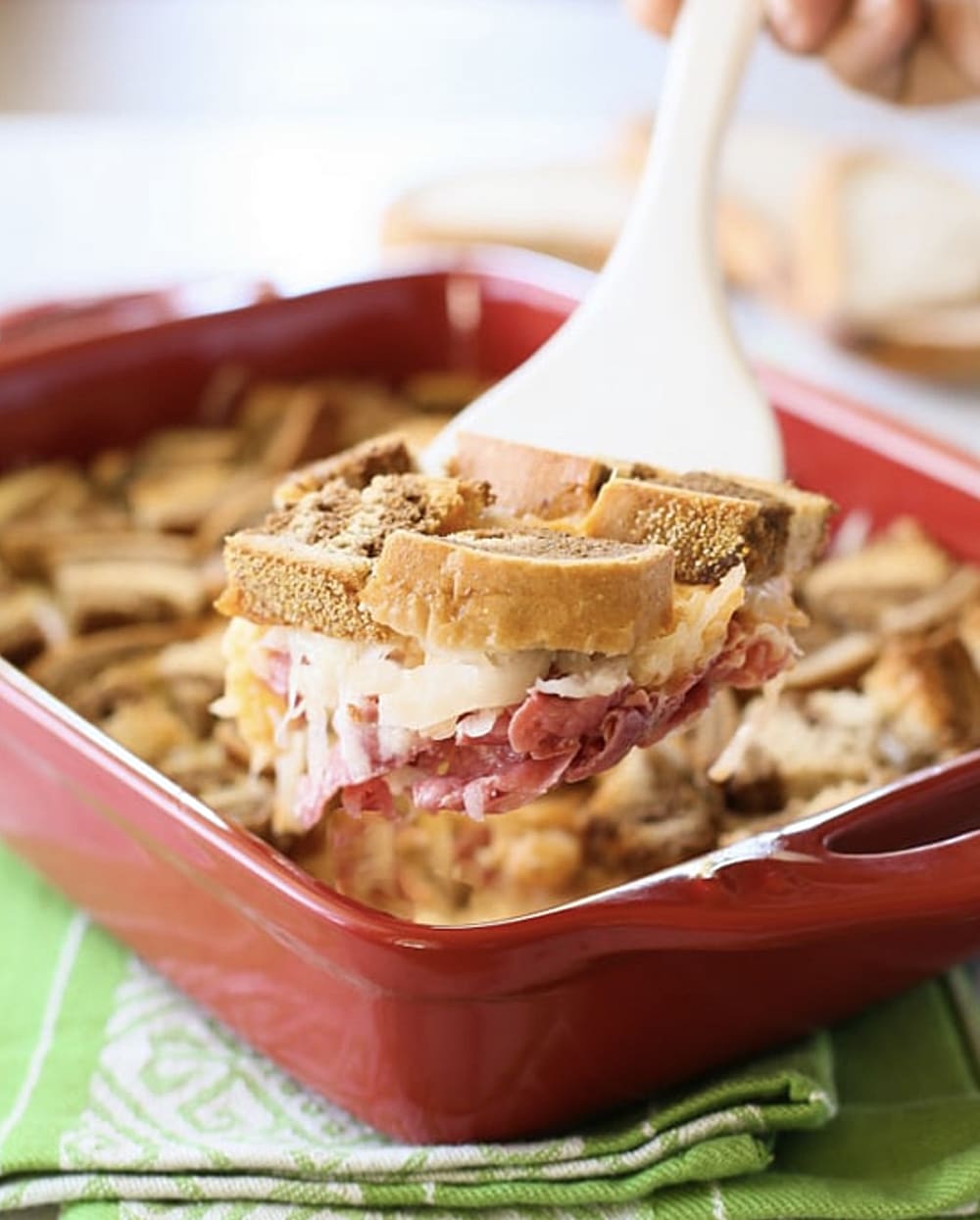
Pro Tips and Troubleshooting
Professional Techniques:
Press the sauerkraut in a fine-mesh strainer for 10 minutes before using – excess moisture is the enemy of a properly set casserole. When layering, leave small gaps between pastrami pieces to allow custard penetration. Room temperature eggs blend more easily into the custard base, preventing lumps and ensuring smooth distribution.
Common Mistake Prevention:
Never skip the 5-minute resting period – cutting too early results in a messy, runny presentation instead of clean slices. If your custard seems too thin, add 1 extra egg to ensure proper setting. Overpacking layers prevents proper custard absorption, so keep layering light and even.
Storage and Reheating:
Refrigerate leftovers for up to 4 days in the original baking dish covered tightly. Reheat individual portions in the microwave for 90 seconds, or reheat the entire casserole covered at 325°F (165°C) for 20 minutes. This casserole actually improves overnight as flavors meld together.
Make-Ahead Strategy:
Assemble completely up to 24 hours ahead, cover tightly, and refrigerate. Add 10 minutes to baking time when cooking from cold. You can also freeze the unbaked casserole for up to 3 months – thaw overnight before baking and add 15 minutes to cooking time.
Scaling Tips:
This recipe doubles perfectly for a 9×13-inch dish – just increase baking time to 50-55 minutes. For half portions, use an 8×8-inch dish and reduce baking time to 35 minutes.

This Reuben Casserole represents everything wonderful about comfort food – it’s familiar yet exciting, indulgent yet satisfying, and guaranteed to become a family favorite that gets requested again and again. The beauty lies in how it transforms a beloved sandwich into something completely new while honoring every flavor that made the original so irresistible. Whether you’re feeding a crowd or just want to treat your family to something special, this casserole delivers restaurant-quality flavors with home-kitchen simplicity.